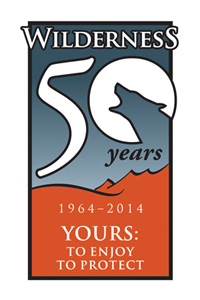|
 |
CELEBRATING THE 50TH ANNIVERSARY of the WILDERNESS ACT
In 2014, we celebrate 50 years of federal wilderness protection and management in the United States.
|
|
On September 3, 1964 President Lyndon B. Johnson signed into law the Wilderness Act.This historic bill established the National Wilderness Preservation System and set aside an initial 9.1 million acres of wildlands, including the Boundary Waters Canoe Area Wilderness, for the use and benefit of the American people. |
 |
WILDERNESS WORDS
Share your thoughts on wilderness values and continue nourishing the distinct American cultural value of wilderness and inspiring generations to love and explore the wilderness. Help celebrate the 50th anniversary by sharing your " Wilderness Words".
Here are "Wilderness Words" that have been submitted to-date:
Ely or Gunflint, Hard to Decide by Kathryn E. Lindner
Knowing When to Turn and Learn to be Still, poems by Chuck Dayton
WHAT IS WILDERNESS? The definition of wilderness according to the Act: “A wilderness, in contrast with those areas where man and his own works dominate the landscape, is hereby recognized as an area where the earth and its community of life are untrammeled by man, where man himself is a visitor who does not remain.”
WHY WILDERNESS? At the time of the 1964 Act-major land development and highway construction was occurring across the US. At the same time, the 60s were the time of the environmental awakening and concern about shrinking undeveloped areas. The National Wilderness Preservation System provides many direct and in-direct benefits, including ecological, geological, scientific, educational, scenic, spiritual, economic, recreational, historical, and cultural uses and activities.
WHO IS INVOLVED? Congressionally designated wilderness areas are managed by the US Forest Service; Bureau of Land Management, National Park Service, and US Fish and Wildlife Service. As public lands, wilderness areas belong to everyone. We can all be stewards of these special places to ensure their protection into the future.
HOW DO YOU MANAGE WILDERNESS? The Act emphasizes maintaining wilderness character as a fundamental management objective. The federal agencies manage designated areas to specifically to protect four aspects of Wilderness character: untrammeled, undeveloped, natural, and solitude or opportunity for primitive and unconfined recreation.
A Leave No Trace (LNT) ethic is vital for maintaining wilderness character. LNT principles are the “Why” behind rules and regulations in wilderness areas and the “How” to meet the intent of the Act.
 |
By practicing Leave No Trace ethics you can help protect wilderness areas from several major threats, including: |
-
Non Native Invasive Species (NNIS)
-
Overuse; i.e. the potential for wilderness to be loved to death.
-
Human interference in natural processes
-
Use of mechanical and motorized devices
-
Pollution (air, water, light, noise)
-
Lack of public awareness of and support for wilderness
 |
Over the past 50 years, and as a result of America's support for wilderness, Congress has added over 100 million acres to this unique land preservation system. Today, there are 757 wilderness areas in 44 states. |
The Boundary Waters Canoe Area Wilderness, with its extensive waterways, is unique among the 757 wilderness areas in the national system. Learn more...
To learn more about the Wilderness Act and the National Wilderness Preservation System, visit http://www.wilderness.net, the official interagency wilderness information website.
|